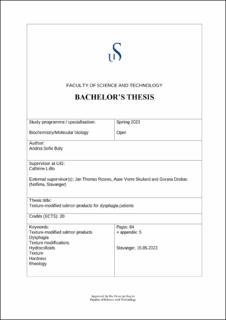| dc.description.abstract | Consuming food plays an important role in a person's quality of life. Dysphagia is a medical condition where chewing and swallowing are difficult, and this condition is most common among the elderly. It can lead to malnutrition, aspiration, low energy levels and reduced life quality. During the next ten years, the number of elderly persons is expected to increase and subsequently, the necessity for more personalised diets, particularly for persons with dysphagia. To prevent the risk of aspiration, texture-modified products with different texture levels have been requested in dysphagia management. In Norway, “Kostholdshåndboken” has categorised dysphagia food into 4 levels, while the International Dysphagia Diet Standardisation Initiative (IDDSI) have suggested a framework for foods and liquids into 8 levels. The municipal age-care kitchen (Sandnes Matservice) currently produces texture- modified products that are not categorised, but they want these products to be used as a reference and to gain knowledge for the production of a softer level aimed for patients with severe dysphagia (IDDSI level 4 – “pureed”).
We developed a total of 9 recipes with salmon as raw material, added combinations of oil, water and the texture modifiers Agar and modified corn starch (Farinex). The preliminary experiments were conducted with Heat Treatment (90 oC for 35 min) or High-Pressure Processing (400 or 600MPa). These products were stored chilled (4 oC) and tested for microorganisms (total viable counts) at day 1 and day 21 and for texture and colour measurements. After the preliminary recipes, 7 new recipes were produced, adjusted with more liquids and less salmon to obtain a softer product. The adjusted products received heat treatment (90 oC for 35 min) and freezing (-30 oC) and were measured in terms of texture, colour, rheology and a Spoon Tilt Test developed by IDDSI.
The microbiological analysis showed low numbers (< log 3 cfu/g) and minimal growth of microorganisms from day 1 to day 21 for both heat-treated and high-pressure processed products. The Farinex products had low hardness (N) values, higher yield stress, higher storage modulus, a higher viscosity (at 1/10 1/s) and a tan delta under 0.6. These values indicate a product safer for swallowing than the control sample and the Agar products produced in this project, thus concluding that the Farinex product was the most adequate in a dysphagia diet. The Agar products showed a low yield stress and lower viscosity levels. This could mean that the product is more liquid, indicating that the product is less adequate than the Farinex products. From these results, it was concluded that the desired texture, IDDSI level 4 - pureed food, was achieved for the adjusted products. | |
